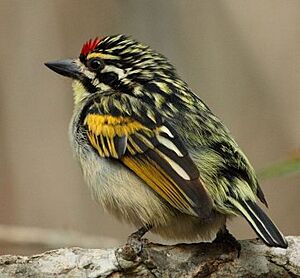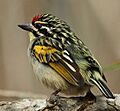Red-fronted tinkerbird facts for kids
Quick facts for kids Red-fronted tinkerbird |
|
|---|---|
 |
|
| Conservation status | |
| Scientific classification | |
| Genus: |
Pogoniulus
|
| Species: |
pusillus
|
| Subspecies | |
|
|
The red-fronted tinkerbird (Pogoniulus pusillus) is a small bird that belongs to the family Lybiidae. Birds in this family are called barbets. They live in warm parts of the world, like Africa and Asia. Barbets have special stiff feathers, called bristles, around their beaks. These bristles look a bit like whiskers!
Contents
All About the Red-Fronted Tinkerbird
The red-fronted tinkerbird is a common bird found in eastern South Africa. You can also find a separate group of these birds from southern Sudan and Ethiopia down to central and eastern Tanzania. Sometimes, people think this bird is the same as its northern cousin, the yellow-fronted tinkerbird.
Where They Live and What They Eat
Red-fronted tinkerbirds like to live in juniper forests and bushy areas. They make their nests inside holes in trees. A female tinkerbird usually lays two or three eggs.
These birds mostly eat berries and fruit, especially from mistletoe plants. They also snack on insects. They like to find their food hidden deep within the plants and trees.
What Does a Red-Fronted Tinkerbird Look Like?
This little bird is about 9 to 10.5 centimeters (about 3.5 to 4 inches) long. It has a plump body, a short neck, a big head, and a short tail.
Adult birds have black feathers on their upper bodies with lots of yellow and white stripes. They also have a bright golden patch on their wings. Their heads have a clear black and white pattern, and they have a special red spot on their forehead. Their bellies and rumps are bright lemon yellow. Male and female tinkerbirds look very similar. However, young birds do not have the red spot on their forehead.
How to Tell Them Apart
It can be tricky to tell the red-fronted tinkerbird apart from other birds.
- Compared to the yellow-fronted tinkerbird: The red-fronted tinkerbird has a red spot on its forehead, while the yellow-fronted one has a yellow spot. The red-fronted tinkerbird also has a golden wing patch and looks a bit darker overall.
- Compared to the red-fronted barbet: The red-fronted tinkerbird is much smaller. It also has a black "moustache" mark and a thinner beak. It doesn't have the wide yellow stripe above its eye that the red-fronted barbet has.
The Tinkerbird's Song
The red-fronted tinkerbird makes a very fast "tink-tink-tink-tink" sound. It repeats this sound about 100 times every minute! This call is very similar to the yellow-fronted tinkerbird's call.
Many larger barbet birds like to sit out in the open when they sing. But the smaller tinkerbirds are different. They usually sing from hidden spots in the trees. This means you are much more likely to hear a red-fronted tinkerbird than to see one!
Images for kids



